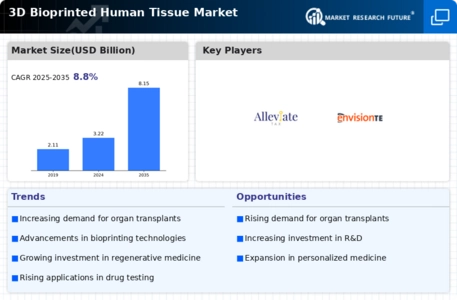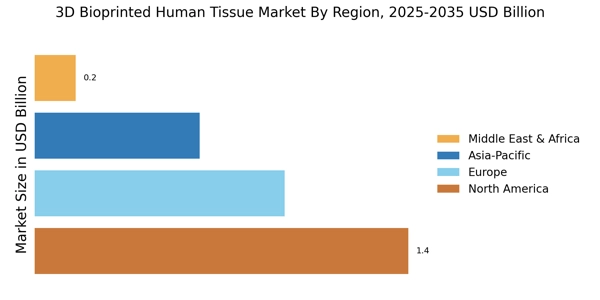Rising Demand for Organ Transplants
The increasing prevalence of chronic diseases and organ failures has led to a heightened demand for organ transplants. The 3D Bioprinted Human Tissue Market appears poised to address this critical need by providing viable alternatives to traditional organ donation. According to recent estimates, the number of patients awaiting organ transplants continues to rise, with thousands on waiting lists. This situation underscores the potential of bioprinting technology to create functional tissues and organs, thereby alleviating the burden on transplant registries. As the technology matures, it is likely that the 3D Bioprinted Human Tissue Market will play a pivotal role in meeting the urgent needs of patients, potentially reducing wait times and improving outcomes.
Advancements in Bioprinting Technology
Technological innovations in bioprinting are driving the evolution of the 3D Bioprinted Human Tissue Market. Recent advancements in materials science, including the development of bioinks that closely mimic natural tissue properties, have enhanced the feasibility of creating complex tissue structures. These innovations enable the production of tissues that not only replicate the mechanical properties of human tissues but also support cellular functions. As a result, the market is witnessing a surge in applications ranging from drug testing to regenerative medicine. The continuous improvement in bioprinting techniques suggests that the industry will expand its capabilities, potentially leading to breakthroughs in personalized medicine and tissue engineering.
Increased Investment in Regenerative Medicine
The growing interest in regenerative medicine is significantly influencing the 3D Bioprinted Human Tissue Market. Investment from both public and private sectors has surged, with funding directed towards research and development of bioprinting technologies. This influx of capital is facilitating the exploration of novel applications, including the creation of patient-specific tissues for transplantation and drug testing. Reports indicate that the regenerative medicine market is expected to reach substantial valuations in the coming years, which could further propel the growth of the bioprinting sector. As stakeholders recognize the potential of bioprinted tissues to revolutionize treatment paradigms, the industry is likely to experience accelerated growth and innovation.
Regulatory Support for Bioprinting Innovations
Regulatory frameworks are evolving to support the development and commercialization of bioprinted tissues, which is a crucial driver for the 3D Bioprinted Human Tissue Market. Authorities are increasingly recognizing the potential of bioprinting technologies to address unmet medical needs. As guidelines become clearer, companies are more likely to invest in research and development, knowing that their innovations can be brought to market more efficiently. This regulatory support not only fosters innovation but also enhances public confidence in bioprinted products. The establishment of streamlined approval processes may lead to a faster introduction of bioprinted tissues into clinical settings, thereby expanding the market's reach.
Growing Awareness and Acceptance of Bioprinting
Public awareness and acceptance of bioprinting technologies are gradually increasing, which is positively impacting the 3D Bioprinted Human Tissue Market. Educational initiatives and outreach programs are helping to demystify bioprinting, showcasing its potential benefits in healthcare. As more individuals become informed about the capabilities of bioprinted tissues, there is a growing willingness to consider these alternatives for medical treatments. This shift in perception is likely to drive demand for bioprinted products, as patients and healthcare providers seek innovative solutions to complex medical challenges. The increasing acceptance of bioprinting could lead to broader applications and a more robust market presence.


















Leave a Comment